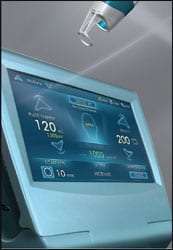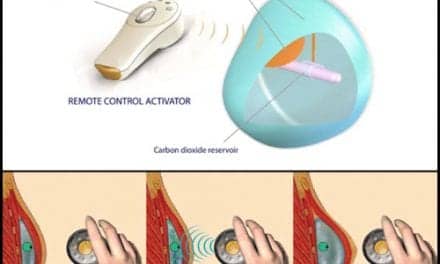 |
The world of skin rejuvenation has, in recent months, taken both a quantum leap forward and a step backward with the introduction of several new laser products.
The forward momentum is supplied by a few technological breakthroughs—CO2 ablative laser products that now provide vastly improved results over past generations—whereas the step back is, well, the fact that ablative, not nonablative, lasers will likely be the “holy grail” of skin resurfacing in the foreseeable future.
Since the mid-1990s, CO2-based ablative resurfacing has been heralded as the gold standard for nonsurgical facial and skin rejuvenation, and removal of facial skin wrinkles.
Over time, however, ablative resurfacing gained a negative reputation among patients, who complained of a prolonged and tough recovery period that frequently spanned 3 weeks, the increased chance of infection, prolonged facial redness that lasted as long as 2 to 3 months, hypopigmentation, and the potential for scarring.
“The early ablative lasers gave you beautifully soft skin, but the problem was that the downtime was horrific,” says Brooke Seckel, MD, FACS, a board-certified physician based in Concord, Mass. The downtime “was not only horrific but people stayed red for 3 or 4 months, and then the skin turned white. Because of this, ablative fell out of favor. In 1998, a slew of companies came out with nonablative devices. The Cool Touch was the most well-known. And the downtime was reduced down to practically nothing, but [the products] didn’t work, either.
“The problem with nonablative was you need ablation to get good wrinkle removal,” he adds.
The new laser products are improved to the point at which treatments are office-based procedures done on an outpatient basis. Recovery times have improved dramatically, according to industry reports and physicians interviewed for this article. In most cases, recovery time for patients is less than 1 week and is usually between 3 and 5 days. Procedure costs can range from $500 to $3,000.
The development of a new technology called fractional laser resurfacing—or fractional skin rejuvenation—has shortened recovery time and reduced the occurrence of complications.
This state-of-the-art technology allows the healing process to be much quicker and enables patients to get back to normal activities sooner.
The new fractional ablative Erbium and CO2 laser resurfacing techniques appear to be the most exciting advances in the field of nonsurgical facial rejuvenation and wrinkle removal in some time, says Dennis Rogers, MD, an aesthetic surgeon based in London.
“The future will see several revolutionary applications that are being developed, which will improve our ability to rejuvenate the skin and improve scars, stretch marks, and remove pigment,” he claims.
Although the new devices come with company claims that vary slightly from product to product, all of the laser products claim to do roughly the same things:
- cause immediate skin tightening;
- stimulate new collagen formation and plump the skin; and
- restore the skin to a healthy, youthful-looking state.
HOW DO THEY WORK?
The process of directing a light source to damage a selected area of the skin is known as “selective photothermolysis.” Ablative lasers direct a short but intense burst of laser energy at the surface of the skin.
This energy heats the water within the skin’s surface layers, causing both the water and the tissue of the skin to vaporize.
The laser is also directed to penetrate the skin to a predetermined depth. When the laser passes over the skin, its outermost layers are removed in a precise and controlled way.
As the skin heals over time, new layers of collagen form and the skin literally resurfaces itself. The resulting skin looks and is healthier than before.
Ablative laser treatments can noticeably reduce the appearance of lines, wrinkles, and pigment.
Nonablative lasers use lower energy levels than ablative lasers and damage the dermal layer of the skin without removing the outer epidermal layers. This approach lessens the recovery period and lowers the chance of complications.
Fractional photothermolysis is a process that attempts to damage only certain zones within a selected target area of the skin. The process produces tiny dot, or pixel-like, treated areas on the skin, and leaves the remaining zones intact and undamaged.
In this way, the skin can heal faster than if the whole area was treated. Untreated tissue then surrounds the treated areas and fills in the damaged area with new cells.
Fractional laser technology can be applied to either ablative or nonablative laser skin rejuvenation. The proper use of fractional laser products, as well as the configurations for certain procedures and other settings, are up for continual debate among physicians.
But one thing is certain: the technology is here to stay.
A SMALL BUT GROWING CIRCLE
 |
Leading the pack of CO2-based systems, according to Seckel, is the Fraxel re:pair Laser from Reliant Technologies Inc.
The Fraxel re:pair system provides a unique Fractional Deep Dermal Ablation (FDDA) system that induces ablation, followed subsequently by tissue contraction, tightening, and collagen remodeling. The laser treats a portion of the skin’s surface and leaves the surrounding areas intact to allow for faster healing.
It emits laser light with a wavelength of 10,600 nm. The re:pair laser system is an FDDA approved for ablation, coagulation, and skin-resurfacing procedures. This system will treat to depths measuring more than 1.6 mm, and differs from the other CO2 lasers in its smaller micrometer spot size.
Another, equally high-profile new product, DeepFX, is from Lumenis Ltd. Lumenis has been slowly releasing a line of devices that support UltraPulse, the firm’s proprietary CO2 fractional laser technology. The company’s CO2 laser line—PigmentFX, ActiveFX, and TotalFX—now includes the recently unveiled DeepFX.
As with nearly all the products in this space, DeepFX is designed to work in tandem with one or more of the firm’s other laser products—in this case, treatments performed using the ActiveFX device, another Lumenis product, work well with the DeepFX, says the company.
Lasering has developed the MiXto line of fractional CO2 lasers that introduces a new type of scanner that maximizes the time between pulses, thus eliminating the need for cooling and for anesthesia in most procedures, according to the firm. The MiXto line is sold in the United States by Quanta.
The device offers microspot technology with a scanning delivery system, and clinical data on it is still unpublished.
Alma Lasers Ltd took the wrapper off of five new products at the 66th Annual Meeting of the American Academy of Dermatology in San Antonio in February.
The new products include the Harmony Multi-Application System, Pixel CO2 OmniFit handpiece, Pixel Er OmniFit handpiece, Pixel CO2 System, and Accent UniLarge handpiece.
The Pixel CO2 OmniFit and the Pixel Er OmniFit handpiece convert nearly any competitive CO2 and erbium skin-resurfacing laser to a fractionated output to provide shorter healing times with the performance of traditional CO2 and erbium treatments.
The Pixel CO2 stand-alone system uses the firm’s proprietary passive optic fractional technology to provide skin resurfacing for the treatment of acne scars, photo-damaged skin, wrinkles, and rhytids, the company says.
Palomar’s Lux 1540 fractional device is a 1540-nm erbium glass fiber nonablative laser that delivers to the skin in microbeams combined with contact cooling of the skin’s surface.
The device can penetrate up to 1 mm deep into the skin, creating columns of coagulated tissue surrounded by healthy tissue.
Affirm from Cynosure is a 1440-nm Nd:Yag nonablative laser that uses a proprietary technology called Combined Apex PulseSM.
The technology includes a special lens mounted over the end of the laser, consisting of roughly 1,000 diffractive elements per cm2, which targets the superficial layers of damaged skin and provides both a high and low energy of light in the treatment zone.
The Profractional, from Sciton, is a 2940-nm fractional ablative device. The treatment head, which measures 20 mm x 20 mm, can produce a variety of pattern configurations on the skin depending on the condition of the skin and the procedure. Depending on the setting, the configuration dots penetrate the skin from 25 to 1,500 µm in depth.
Lutronic USA’s fractional laser system, Mosaic, utilizes a patented technology called Controlled Chaos Technology that delivers multiple arrays of randomized microscopic laser beams to the skin.
The company calls this a “spray paint” approach that reportedly eliminates the need for multiple linear passes as well as unavoidable overlap.
CO2 VERSUS ERBIUM
 |
| See also “Preemptive Strikes” by Danielle Cohen, in the May 2007 issue of PSP. |
“With ablation, wrinkle removal is better because with the fractional [devices], the downtime is less,” Seckel explains. “It’s taken 13 years for us to get the technology up to where we promised it would be in 1998.”
Is there a reason for choosing a CO2 laser over an erbium laser?
“CO2 produces heat, and you won’t get skin tightening without the level of heat,” Seckel says.
“Lumenis, which makes ActiveFX and the new Bridge technology, believes the same thing. Palomar’s device takes a different approach—they focus on depth of penetration. They have an erbium ‘cool laser.’ Not as much heat. You don’t have the thermal injury to the skin you get with re:pair and Lumenis Bridge, but you get the same depth. I’m convinced that all three of these lasers are the way to go in the future. The big argument is CO2 or erbium?” Seckel continues.
Wrinkle removal and skin plumping, according to Seckel, revolve around depth of penetration, “and heat has nothing to do with it,” he says.
Both CO2 and erbium devices are effective, but “erbium will have a little less downtime,” Seckel adds.
Shannon Triplett Leade is a contributing writer to PSP. She can be reached at [email protected].



